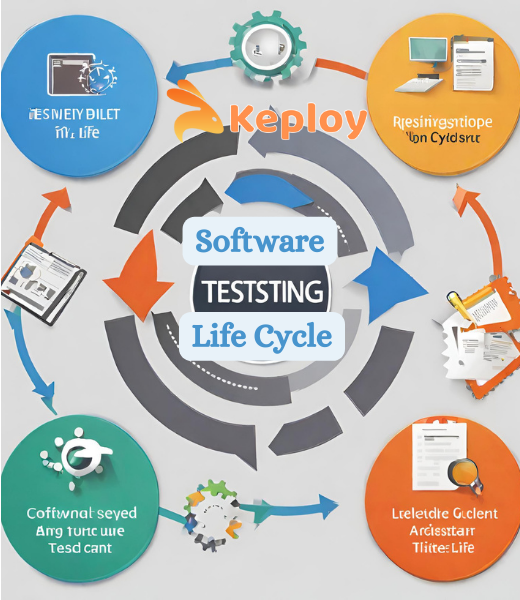

The Software Testing Life Cycle (STLC) is a systematic process that ensures software quality by following a series of stages designed to validate that the product meets requirements and is free of defects. Much like the Software Development Life Cycle (SDLC), STLC consists of distinct phases that guide the testing team from planning to test execution and reporting, ensuring that every part of the system is thoroughly evaluated before release.
Importance of STLC in Software Development
STLC is essential for delivering high-quality software because it provides a structured approach to testing, enabling early detection of defects and reducing the risk of critical errors reaching production. By following a formalized process, testing teams can ensure comprehensive coverage, better coordination with development teams, and ultimately, improved software quality. This structured approach not only saves time and resources but also helps avoid costly fixes after the software has been deployed.
Phases of the Software Testing Life Cycle
Each phase of the STLC serves a specific purpose in ensuring that the testing process is effective and aligned with the overall goals of the project. Together, these phases offer a methodical way to detect and resolve issues before the product is delivered to users.
Requirement Analysis
In the requirement analysis phase, the testing team reviews the software requirements to understand what needs to be tested and identifies testable requirements. During this phase, testers collaborate with stakeholders, including developers and business analysts, to clarify ambiguous requirements and identify potential gaps. This helps ensure that testing is aligned with the product's expected behavior and business objectives, setting the foundation for all subsequent testing activities.
Test Planning
Test planning involves defining the testing strategy, estimating resources, and creating a roadmap for executing tests efficiently. This phase is critical for determining what needs to be tested, which tools will be used, and how testing will be integrated with the overall development cycle. Test managers draft a comprehensive test plan that outlines the scope of testing, testing objectives, roles and responsibilities, risk assessment, and scheduling. The goal is to ensure that the testing process is well-organized and that potential obstacles are identified in advance.
Test Case Design
During test case design, the team creates detailed test cases that outline how to validate different functionalities of the software. Each test case specifies the test inputs, actions, and expected outcomes for various scenarios, ensuring that the software behaves as intended. Well-written test cases help testers ensure that they cover all possible user interactions and edge cases. This phase also includes the creation of test data, which will be used to validate the different aspects of the software during execution.
Test Environment Setup
The test environment setup phase ensures that the necessary hardware, software, and network configurations are in place to conduct the tests. In this phase, teams create a test environment that mimics the production environment as closely as possible. Testers need access to databases, servers, and other components that the application interacts with. Proper test environment setup ensures accurate test results and minimizes the risk of environmental issues affecting the outcome.
Test Execution
In the test execution phase, testers run the designed test cases on the application to identify defects and report any issues found. Testers execute the test scripts manually or automatically and compare the actual results with expected outcomes. If discrepancies are found, they are logged as defects, which are then communicated to the development team for fixing. This phase is iterative—once bugs are fixed, tests are rerun to ensure that the issues have been resolved and that new defects have not been introduced.
Test Reporting
Once test execution is complete, the results are analyzed and consolidated into detailed reports that summarize test coverage, defects, and overall quality. Test reports provide stakeholders with insights into the stability and reliability of the software, highlighting areas of concern and the current state of defect resolution. These reports play a critical role in decision-making, allowing project managers and stakeholders to determine whether the product is ready for release or requires further refinement.
Test Closure
Test closure marks the final stage of the STLC, where the team assesses the test results, finalizes documentation, and evaluates lessons learned for future projects. In this phase, teams document any unresolved defects, assess test coverage, and create a final report that details the overall test execution process. The team also conducts a retrospective to identify what went well and areas for improvement, ensuring that future projects benefit from the lessons learned during the current testing cycle.
Best Practices for Implementing STLC
Following certain best practices ensures that the STLC is applied efficiently, maximizing the value of the testing process:
• Early Involvement: Involve testers early in the SDLC to ensure better understanding of requirements and early detection of potential issues.
• Automation Where Feasible: Automate repetitive test cases to save time and focus on more complex, exploratory testing tasks.
• Continuous Feedback Loop: Establish a feedback loop between testing and development teams to ensure quick resolution of defects.
• Risk-Based Testing: Prioritize testing of high-risk areas that are critical to the product's functionality.
• Clear Documentation: Maintain thorough documentation at every stage of the testing process for future reference and compliance purposes.
Conclusion: The Importance of a Structured Testing Approach
The Software Testing Life Cycle plays a pivotal role in ensuring that quality is maintained throughout the development process, helping deliver reliable and defect-free software products. By following a structured approach, testing teams can ensure thorough coverage, reduce the risk of missed defects, and improve collaboration between development and testing teams. As software complexity grows, an organized and methodical approach to testing becomes even more essential in maintaining the high quality that users expect from modern applications.
The above is the detailed content of Software Testing Life Cycle (STLC): A Comprehensive Guide. For more information, please follow other related articles on the PHP Chinese website!




